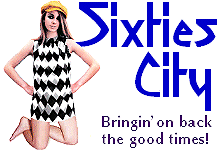

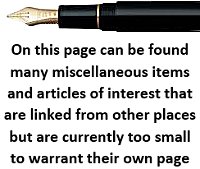
 |

|
 |
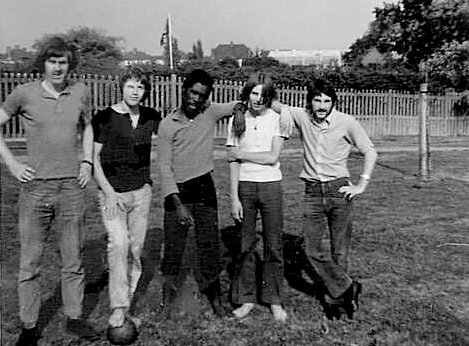 Dry Ice, Prestwick, 27th June 1970 L-R Les Thompson, John Fitzgerald, Les Charles, Jim Singleton, Mick Olive |
Dry
Ice and Billy Ocean Leslie Thompson* writes: In December 1967 I joined a band ’The Shades of Midnight’ who were resident band at the Blue Coat Boy in Shoreditch. The pub was tightly packed at weekends, but looking back on it I don’t think the band was the main reason. We had a decent singer, Duane Robinson, and a series of very good guitarists, who always seemed to leave after a month or two. In September 68 Duane left and I did too, but rejoined a couple of months later. On Monday 3rd March 1969 we held auditions for a new singer at the Blue Coat Boy. Head and shoulders above the rest was a local lad, Les Charles, but on 20th July 1969 he left the band, and so did I shortly after. In the spring of 1970 I had formed another band, ‘Dry Ice' and asked Les Charles to join us. By May we were doing gigs around North London and we recorded some demo tapes that summer. One of our regular gigs was in the Marquis of Sailsbury, Balls Pond Road, and it was there in the winter of 1970 a couple of producers came in from their studio just around the corner, and were impressed enough with our singer to offer us a record deal. That didn’t last too long as the band were not really a match for Les Charles. He left the band in January 71 changed his name to Billy Ocean and became one of the most successful British black artists. * Leslie Thompson uses the stage name Basil Bunelik when performing East European music. He currently (2024) works with the Amber Fire Ceilidh Band based in Devon and the West Country. Billy Ocean: Born Leslie Sebastian Charles in Fyzabad, Trinidad, on January 21st 1950, moving to London's East End at the age of 8. He worked as a tailor's apprentice on Savile Row as a teenager. He recorded several singles in the 1970s under such stage names as Piggy Bank, Scorched Earth, and Sam Spade. He was working at a Ford auto assembly plant at the age of 25 when his single “Love Really Hurts” reached number two in the U.K. charts. |
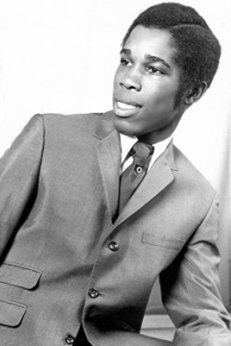 Billy Ocean / Leslie Charles |
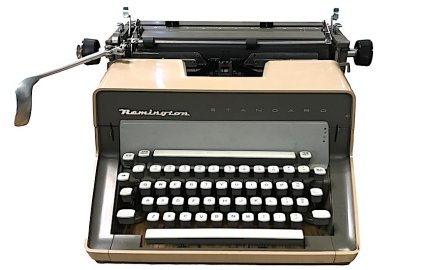 |
Recollections
of Sixties Employment It was in the summer of 1960 that I was temporarily employed by Remington Typewriters in their Hammersmith service department. My job was to deliver bits and pieces to offices around the West End and the City on the company’s 175 Lambretta. I quite enjoyed this, particularly chatting up the many secretaries and typists to be found in the offices of those days and I enjoyed a modicum of success in that sphere. However, with winter approaching, I sought more congenial employment and landed a job in the men’s shoe department of Barkers in Kensington High Street. The floor walker to whom I was assigned was indistinguishable from “Captain Peacock” (the TV character created more than a decade later) and he made no effort to conceal his dislike of me. Like so many who had not enjoyed a particularly “good war”, he insisted that he be accorded the military honorific. This rather irked me as in those days, it was the convention that only officers of field rank could maintain their former status in civilian life. Anyway, the “Captain” was off the floor when I served someone who seemed a typical London wide boy with unusually large feet. I recall that he bought a pair of black Gibsons and a pair of suede desert boots. Peacock returned just as this chap was leaving. “Do you know who that person was?” “No - should I have done?” “That was only Max Bygraves and you should have let me attend to him”. I did not possess a telly and listened only to the Third Programme, so completely failed to recognise the evidently famous personage. This provided him the opportunity to get rid of me and I was transferred to the women’s shoe department of Derry and Toms a bit further along the High Street. They had flamingos on the roof garden which often provided conversation more stimulating than that of the punters downstairs. Tired of jamming bunions into low-heeled courts and avoiding the predatory interests of some of the old biddies, I then transferred to Pontings nearer the Earl's Court Road, the third and down-market department store of the Barker group. For a few months I toiled in the Manchester department flogging lengths of damask and uncut moquette. After sabotaging the overhead mechanical receipt/change providing system, I left this mausoleum and went into the motor trade. Barker’s, D&T and Pontings as well as Remington’s place in Hammersmith are now long dead. But thanks to this interesting site, memories can be preserved and shared. |
| Recollections
of Soho Back in 1959, I worked for a large advertising agency in Fetter Lane, EC4, to where I commuted on a Lambretta. I was an organist, occasionally playing for services in City churches and it was the organists’ affinity with JS Bach that led me to spending the occasional lunch hour in the wartime ruins of St Anne’s in Wardour Street. An 18th century organist there had been a friend of the composer and it was for him that the great St Anne fugue was written. Given that Bach’s history lay in the then East Germany, Wardour Street was as close as I was likely to get to my musical hero! A girlfriend was the personal assistant to the delightfully urbane James Shand who ran the Shenval Press from 58 Frith Street; a firm highly respected in the world of print and the graphic arts. I still remember the phone number – GERrard 3912! Ruari McLean edited Motif (an imprint of the Shenval Press) from the same address and this proved well placed for observing the goings-on of the local populace. This (1960) was only a year after prostitutes had been banned from soliciting on the streets of London, so many of the entrances to the predominantly Georgian buildings in Frith Street bore small notices advertising “Violin Lessons” and similar musical instructions. There was no shortage of aspiring Paganinis, some of whose lessons were remarkably short! Originally opposite the "Two i’s" bar in Old Compton Street (where I saw a young Eden Kane), the restaurant “Act One, Scene One” relocated close to the corner of Wardour Street and Brewer Street. Here one could rub shoulders with all manner of celebrities from the theatrical world; we once shared a table with David Jacobs and Frank Finlay. Oscar and Ina who had a small handbag factory in Brewer Street were regulars here as were many film people from the top end of the street. Much of my shopping was done in the Berwick Street market and Soho Square is remembered for crashing my scooter there in the snow of that awful winter of ‘62/’63. Old Compton Street was not without its interests. The flamboyant Prince “I gotta horse” Monolulu was regularly shouting the odds and there was a chap with a large tap attached to his forehead by a red, rubber suction cup and who would dart out from shop doorways to squirt anyone within range with a spray of rose water. He disappeared from time to time during which absence we supposed he was back in the mental home. I was awarded a small bonus for some forgotten reason and treated myself to twenty exotic Sullivan Powell Turkish cigarettes from Coleman Cohen on the Frith Street corner. This shop was noted for the sale of quality cigars and since in those days one did not light a cigar with a cigarette lighter - only a match - the counter held a polished brass standard which provided a permanently lit flame from which you could fire up your new Romeo y Juliet. Or, on the odd occasion when I could afford anything more expensive than Woodbines, an American White Owl but the man behind the counter made it plain that my choice of smoke was not in the best of taste. I suspect taste was defined as a function of cost! I used to provide piano accompaniment for a dancer who practiced at the Max Rivers studios near Newport Place (where there were several HiFi shops – a bit like Tottenham Court Road) on the other side of Shaftesbury Avenue, but that may not have been in Soho, which, incidentally, I do not recall as being “Chinatown”. Certainly, there were Chinese restaurants there, Ley-On’s being the best remembered; I imagine “Chinatown” must be a more recent and probably American import. I’ve not been there since 1963, preferring to leave treasured memories untarnished by the subsequent changes made to the fondly-remembered London of my early twenties. |
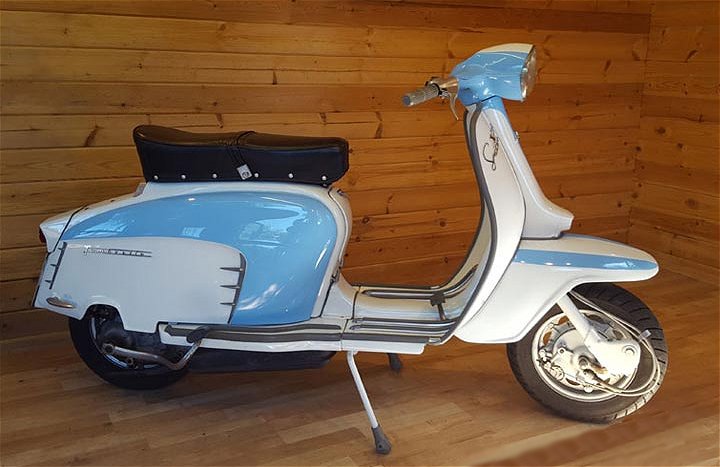 |
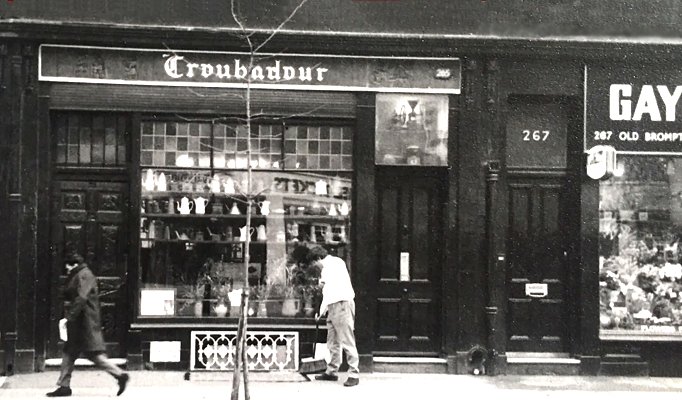 |
Recollections
of Troubadour Kevin Barry’s recollections of World’s End in Disconnected Jottings have prompted a few of my own as I was in that general area from 1959 to 1963. For some of that time I lived in a basement flat in Coleherne Road. Occasionally I deputised for the organist at St Luke’s in Redcliffe Gardens and, as a musical diversion, I was learning the Spanish guitar from a friend who lived opposite in Wharfedale Street. Around the corner in Old Brompton Road was the Troubadour coffee bar owned by the Canadian, Mike la Mare. I believe the magnificent front door, carved by my guitar-tutoring friend, is still there. Here, on Wednesday evenings, there would be Flamenco dancing in the hot and dingy basement and it was here that I took my first (and only!) public steps in Bullerias and Soleares but I can claim the distinction of being in a band accompanying Trader Faulkner and Ron Hitchins. Sunday evenings were devoted to Cante Jondo recitals which were way beyond my accompanying abilities, although it was usually me who was expected to provide the singer’s inducement of a bottle of Graves obtained with some personal trepidation from the Coleherne Ams on the corner. A few shops in the direction of Warwick Road was one of the first Indian restaurants in London, known as The Green Mask but called the Green Man by the locals. Veeraswamy’s had been in Regent Street since before the war, but there were hardly any others around at that time. This was a small, unpretentious place converted from its former double-fronted shop and my girlfriend and I occasionally would push the boat out on pay day; Dublin Bay prawn curry and pilau rice was 7/6d. Food was excellently cooked in the basement kitchen and sent up on a dumb waiter. Hattie Jacques and John le Mesurier dined there quite frequently and we became nodding acquaintances. On one occasion they were joined by Kenneth Williams who was excruciatingly funny but, we thought, rather overpowering. On the ground floor of the Redcliffe Close block of flats opposite, there was a Polish delicatessen (Sklep Polski) which seemed terribly sophisticated for the time. At the western end of this block, on the corner diagonally opposite the Princess Beatrice hospital, was the London showroom of the German car maker, NSU, displaying a range of these small cars of which the TS coupe was quite pretty. On the corner of Old Brompton Road and Coleherne Road, opposite the Coleherne Arms, was a chemist shop. This became Dinty Moore’s café and subsequently a hardware shop run by one of the Bertorelli family who had cheap restaurants in South Kensington and another just along from the hardware shop. It was here when previously boarding in Coleherne Court, Old Brompton Road, that due to chronic impecunity I ate the same meal every evening for nine months – Vienna steak and chips priced at a whopping 3/6d which included a cup of tea. This place afterwards became a Chinese restaurant. Sometimes, I played at St Mary the Boltons and remember catching the odd glimpse of Douglas Fairbanks Jr who lived in a very large house nearby. I also enjoyed the organ played by Sir Arthur Sullivan when he was resident at a church towards the Fulham Road and whose dedication is forgotten but I believe it later became a Greek Orthodox centre or something similar. These are just a few of the myriad happy memories of my time in what is now a profoundly alien London. |
|
|
All
Original Material Copyright SixtiesCity
Other individual owner copyrights may apply to Photographic Images |